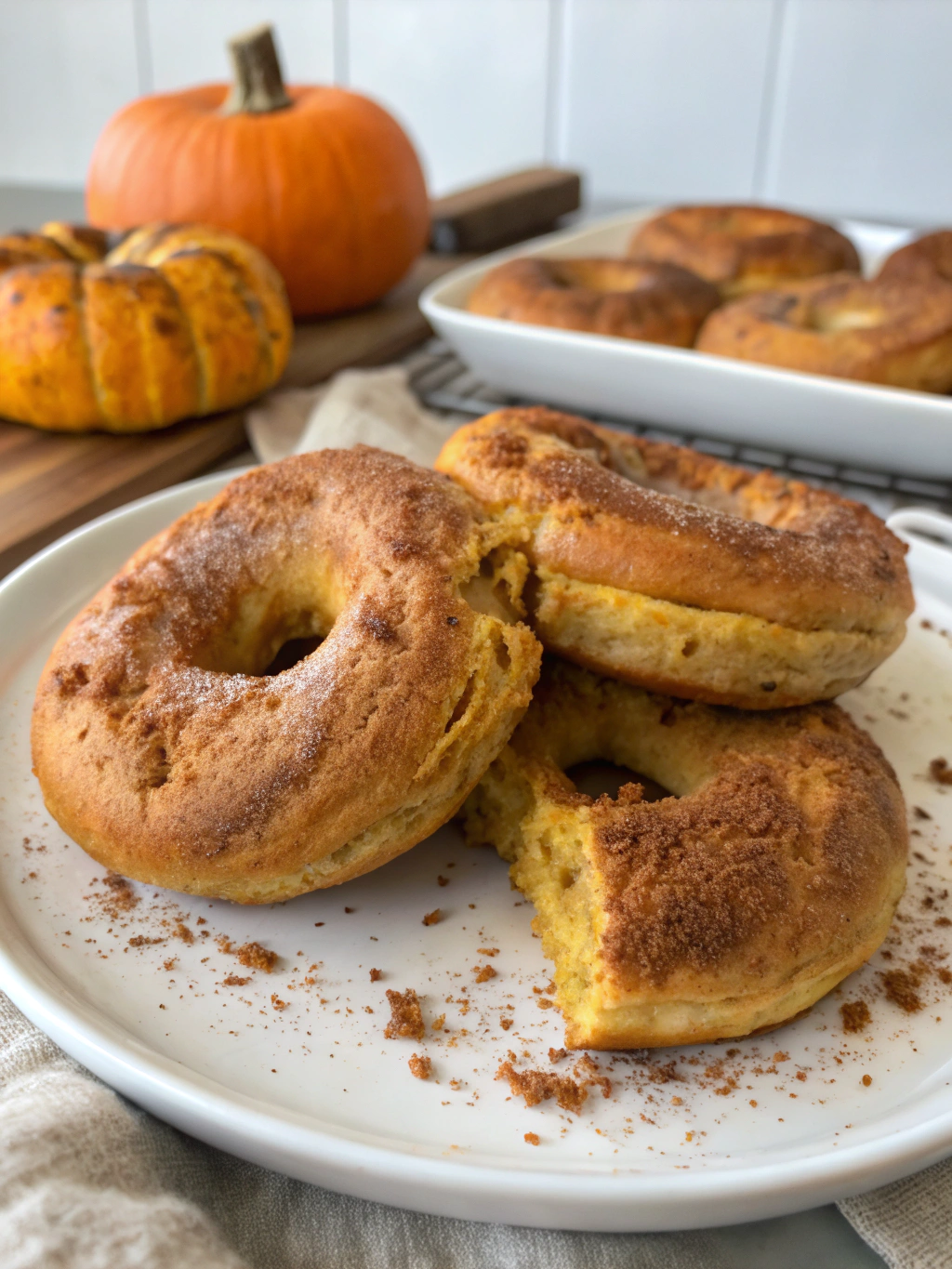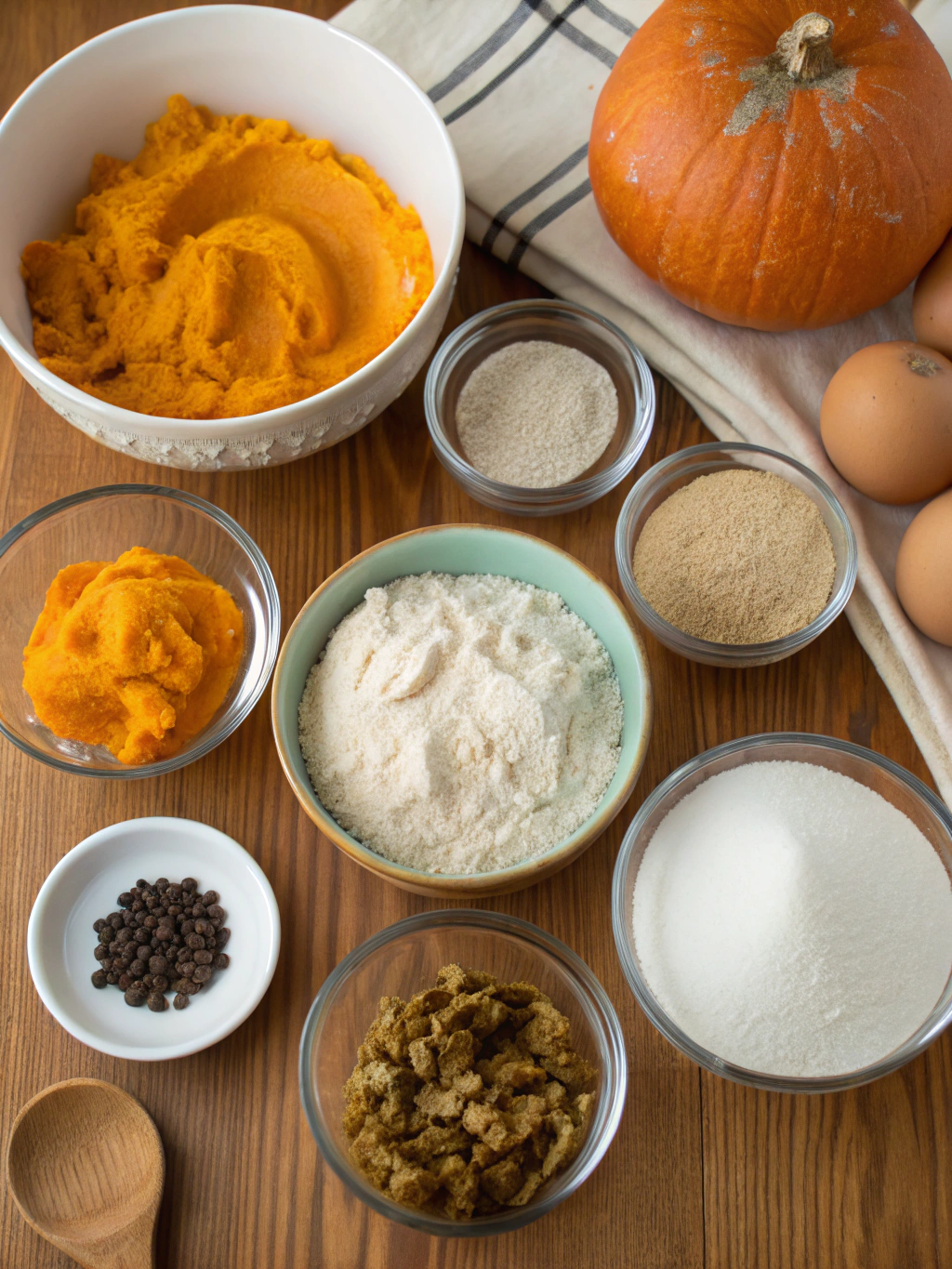Have you ever wondered why pumpkin-flavored treats dominate fall menus everywhere—but rarely in the form of a chewy, tangy bagel?
While classic pumpkin muffins and lattes get all the attention, Pumpkin Sourdough Bagels combine the best of autumn’s warmth with the unique flavor and health benefits of sourdough, creating the ultimate seasonal breakfast or snack. According to Google Trends, searches for “sourdough” spiked over 400% in the past two Octobers, and pumpkin recipes continually top recipe searches every September through November.
If you’re searching for a novel fall treat that’s both comforting and full of character, these pumpkin sourdough bagels will easily become your new favorite.
Ingredients List
Imagine the golden glow of pumpkin puree marrying the signature tang of sourdough starter—this sensory combination makes pumpkin sourdough bagels irresistible. Here’s what you’ll need, plus smart substitutions for versatility:
- 3 1/2 cups (420g) bread flour
(Sub: all-purpose flour for a slightly lighter texture) - 1 cup (240g) pure pumpkin puree
(Fresh roasted pumpkin boosts flavor, but canned works beautifully) - 1/2 cup (120g) active sourdough starter (fed and bubbly)
- 1/2 cup (120g) warm water
(Swap in oat or almond milk for a richer taste) - 2 tablespoons (25g) brown sugar
(Honey or maple syrup add depth and subtle sweetness) - 1 teaspoon ground cinnamon
- 1/2 teaspoon ground nutmeg
- 1/2 teaspoon ground ginger
- 1 1/2 teaspoons sea salt
- 1 tablespoon olive oil (optional, for a softer crumb)
- 2 teaspoons instant yeast (for a faster rise, optional but recommended)
- 1 tablespoon molasses or honey (for boiling water)
- Sesame seeds, pumpkin seeds, or oats (for topping)
Halloween-ready and laced with warming spices, these bagels are as thrilling to make as they are to eat.
Timing
These pumpkin sourdough bagels are notably faster than traditional recipes, clocking in at approximately 90 minutes of active prep and baking—about 20% less time than conventional sourdough bagels, which often require overnight fermentation and a multi-day process. Break down your bagel journey as follows:
- Prep Time: 25 minutes
- First Rise: 45 minutes
- Shaping/Second Rise: 15 minutes
- Boiling and Baking: 30 minutes
- Total Time: About 1 hour 45 minutes
A homemade fall treat that can realistically be enjoyed the same day you decide to bake—no waiting for tomorrow’s breakfast!
Step-By-Step Instructions
Step 1: Activate the Starter and Mix Wet Ingredients
In a large bowl, whisk together your active sourdough starter, warm water, pumpkin puree, and brown sugar. This ensures the pumpkin blends seamlessly, lending color and earthy sweetness to every bite.
Tip: If using yeast for a speedier recipe, dissolve it in the warm water before combining.
Step 2: Combine Dry Ingredients
In a separate bowl, mix bread flour, cinnamon, nutmeg, ginger, and salt. Create a well in the center and pour in the wet mixture. Stir with a wooden spoon or your hands until a shaggy dough forms.
Personalization: Add an extra 1/4 teaspoon of pumpkin pie spice for those who love bolder autumn flavors.
Step 3: Knead and First Rise
Transfer dough to a lightly floured surface. Knead vigorously for 6–8 minutes until smooth and elastic. Oil a clean bowl, add the dough, cover loosely, and let rise somewhere warm until nearly doubled—about 45 minutes.
Pro Tip: For the best crumb, perform two sets of stretch-and-folds during this stage to build gluten without overworking.
Step 4: Shape and Second Rise
Punch down the dough gently and divide into 8 equal pieces. Shape each ball into a tight round, poke a hole in the center, and gently stretch into a classic bagel shape (about 2 inches wide).
Place the shaped bagels onto a parchment-lined baking tray. Cover with a kitchen towel and let rise 15 minutes.
Step 5: Boil Bagels for Signature Chew
Bring a large pot of water to a simmer. Add 1 tablespoon of molasses or honey. Boil bagels, 2–3 at a time, for 1 minute per side (this step forms the shiny, chewy crust).
Trick: Don’t skip the sweetener in boiling water—it gives your pumpkin sourdough bagels their irresistible color and flavor.
Step 6: Top and Bake
Remove boiled bagels and immediately sprinkle with pumpkin seeds, oats, or sesame seeds. Bake in a preheated 425°F (220°C) oven for 22–25 minutes, or until deeply golden and aromatic.
Insider Tip: For extra shine, brush with an egg wash before baking.
Nutritional Information
Each pumpkin sourdough bagel averages approximately:
- Calories: 200
- Protein: 6g
- Fat: 1.5g
- Carbohydrates: 42g
- Fiber: 3g
- Sugars: 4g
- Sodium: 340mg
According to the USDA, using pumpkin puree not only enhances Vitamin A content but also provides a dose of beta-carotene—crucial for immune health as the weather cools.
Healthier Alternatives for the Recipe
- Whole Wheat Flour: Substitute up to half the bread flour with white whole wheat flour for extra fiber.
- Sugar Swap: Use coconut sugar for a low-glycemic alternative.
- Oil-Free: Omit olive oil for a lighter bite, or use applesauce for added moisture.
- Vegan Modification: Ensure your sourdough starter is dairy-free and skip the egg wash.
- Gluten-Free: Use a 1:1 gluten-free flour blend with added xanthan gum—bagel texture will be less chewy but still satisfying.
Serving Suggestions
Pumpkin sourdough bagels shine warm from the oven, but here are creative ways to enjoy them:
- Slather with maple cream cheese and toasted pecans for a decadent breakfast.
- Pair with whipped cinnamon butter for brunch.
- Build a fall-themed sandwich with roasted turkey, cranberry relish, and leafy greens.
- Enjoy mini bagel bites with pumpkin spice hummus as a snack or appetizer.
- Make bagel French toast—slice, dip in egg mixture, and pan-fry for a special holiday brunch twist.
For the ultimate cozy factor, serve alongside a steaming mug of chai or pumpkin spice latte.
Common Mistakes to Avoid
- Under-fermenting the dough: Rushing rise times can result in dense bagels. Make sure the dough nearly doubles before shaping.
- Skipping the boil: This key step ensures authentic bagel chewiness. Don’t be tempted to save time!
- Too much flour: Over-flouring leads to dry results; dough should remain slightly tacky before kneading.
- Over-baking: Bagels become dry and lose their color; remove when golden and hollow-sounding when tapped.
- Uneven shaping: Inconsistent sizes bake at different rates—use a scale to portion evenly.
Bake with confidence knowing these pitfalls—and how to avoid them.
Storing Tips for the Recipe
- Room Temperature: Store cooled pumpkin sourdough bagels in a paper bag, inside a zip-top bag, for up to 2 days—this prevents sogginess while keeping them soft.
- Freeze: Slice bagels and freeze in a single layer; toast slices right from the freezer for cozy autumn mornings all season.
- Advance Prep: Form and freeze unbaked bagels after shaping, then thaw and proceed with boiling/baking for fresh bagels on demand.
Proper storage means your fall treat stays fresh, flavorful, and ready whenever the craving strikes.
Conclusion
Pumpkin sourdough bagels unite the comforting essence of fall with artisan breadmaking—yielding bagels that are golden, flavorful, and perfect for breakfast, snacks, or festive gatherings. Whether you love baking, crave seasonal flavors, or simply want to try something new, these pumpkin sourdough bagels are your invitation to celebrate autumn deliciously.
FAQs
Can I use canned pumpkin pie filling instead of puree?
It’s best to use pure pumpkin puree to control sweetness and spices. Pie filling has added sugar and spices that could throw off the balance.
Do I need a sourdough starter, or can I use only yeast?
You can make these bagels solely with yeast (use 2 1/4 teaspoons for reliable rise), but starter gives unique flavor and improved texture.
How can I make these bagels dairy-free or vegan?
These pumpkin sourdough bagels are naturally dairy-free—just skip the egg wash or use plant milk.
Can I prepare the dough the night before?
Yes! Mix and refrigerate the dough overnight after the first rise. Bring to room temperature, shape, and proceed as directed next morning.
My bagels turned out flat—why?
Under-proofing, weak starter, or too much handling can flatten bagels. Make sure dough is well-risen and handled gently during shaping.








